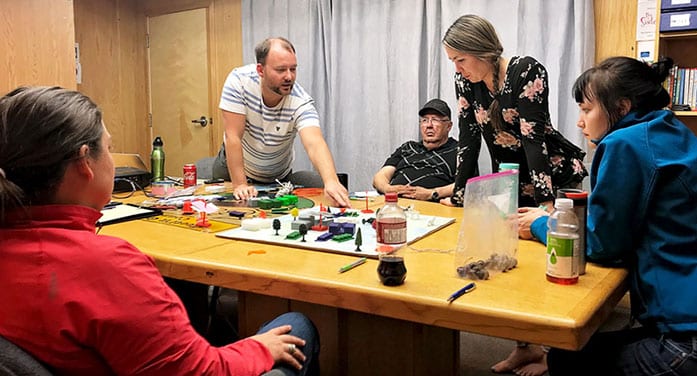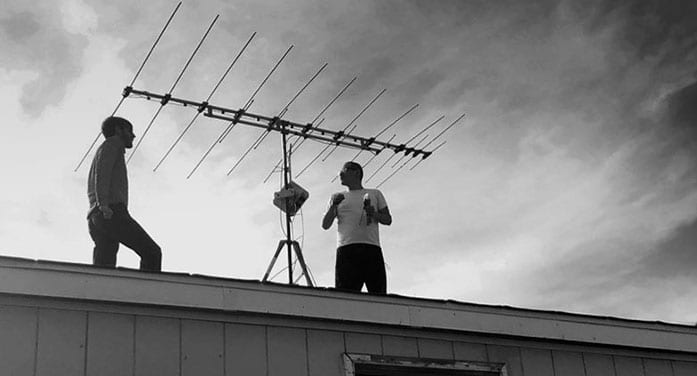When Bruce Buffalo returned to Maskwacis after years away in the big city, he was appalled to discover parts of his community still had no internet service.
Just an hour’s drive from Edmonton, some neighbourhoods in the Indigenous community remained cut off from the rest of the world as recently as 2016, apart from a few people who could afford land lines.

So Buffalo decided to build a high-speed internet connection himself, scaling his family’s rooftops to put up the first antennas.
“An internet service provider takes a lot of money, and someone like me, I don’t got much money,” Buffalo explained in the Al Jazeera documentary Broadband Bruce: Fighting Canada’s Digital Divide.
“I’m just the small guy. I’m not even employed,” he said at the time. “But you gotta make a difference where you can, and when you can.”
At first, he crowdsourced enough money to serve between 20 and 30 people, then raised more funds for a few more connection points, reaching about 150.
Five years later, the “Robin Hood of the Internet” is now chief technical officer for the Mamawapowin Technology Society, which offers free, public Wi-Fi access to Samson Cree residents in the Maskwacis townsite and beyond.
Buffalo is an inspiring example of Indigenous communities taking technology into their own hands when left out in the cold by the big telecommunications companies. But he is by no means the only one, according to Rob McMahon, a professor of media and technology studies in the U of A’s Department of Political Science.
“Bruce is self-taught, an amazing person who started by building a personal internet,” said McMahon. “It really shows that anyone can get up on the roof and install an internet connection.
“There’s more than one way to build a network, and Indigenous peoples were right there from the start – unrolling cable and setting up wireless towers
“There may be as few as 100 people in some of these smaller communities, some of which do not have ‘brick and mortar’ stores, banks or other services. But they’re getting together and setting up the system themselves. Because the infrastructure is owned and managed by the community instead of going to shareholders, the revenues circulate inside the community and contribute to sustainable local employment.”
Along with other researchers and First Nations broadband providers from across Canada, McMahon co-founded the First Mile Connectivity Consortium, a national non-profit association of community-based technology organizations.
“The consortium provides a way for researchers to work with Indigenous and organizations to mobilize research and advocate for policy change,” he said, adding that the group also shares lessons learned and showcases digital innovations taking place in rural and northern regions.
In 2016, McMahon and his colleagues presented to the CRTC during public hearings on the “basic service objective” for telecommunications services in Canada. Their efforts – and those of other Indigenous and public interest groups – resulted in a landmark declaration that all Canadians should have access to broadband internet with minimum transmission speeds and unlimited data plans. That basic service objective also brought increased universal broadband funding for Indigenous and non-profit community networks.
Despite that policy victory, many rural and northern communities continue to experience the “digital divide” with limited, expensive internet services, said McMahon. Research his team conducted in the Northwest Territories exposed “abysmally” poor service from the major commercial provider, far below transmission speeds considered barely adequate.

To address those ongoing challenges, he points to the remarkable success of Indigenous networks, notably K-Net in northwest Ontario, which connects about 80 communities over satellite and fibre optics, and has even set up its own cellular phone network.
“They’re a full-service, registered internet service provider supporting everything from online health, online schools – even an internet high school – as well as household internet services provided by locally managed networks.”
Some Indigenous networks like K-Net have established co-operative network management policies that share and “triage” limited bandwidth according to priorities set by communities, said McMahon.
“So say you have someone who needs to see a doctor in one remote community; there might be an agreement with other communities in the network to share that bandwidth resource – for example, turning up speed and bandwidth to support health service delivery while turning them down for less essential services like streaming Netflix.”
Solutions such as sharing bandwidth, providing non-profit internet services and circulating revenues inside communities demonstrate how digital literacy and self-determination go hand in hand, he added. Indigenous peoples in Canada have developed deep expertise in managing technical issues such as privacy, surveillance and intellectual property rights.
Some of their most powerful arguments for control of telecommunications reflect broader concerns over sovereignty and jurisdiction over areas like economic development, health and education.
“They’ve thought deeply about these issues since the early days of settler colonialism, so I think we can really learn from their example, especially how to be accountable, responsible digital citizens.”
As for Buffalo, his dream to eventually connect all four nations in Maskwacis is quickly taking shape. He recently struck a partnership with the Maskwacis Cultural College to migrate to their fibre optic system and is applying for a federal universal broadband grant.
Other First Nations are also approaching him for help in creating their own networks.
“One day we’ll be on the forefront of this technology, bringing tech education, economic opportunities and knowledge to all ages in the communities we serve.”
| By Geoff McMaster for Troy Media
This article first appeared in Folio, published by the University of Alberta. Folio is a Troy Media![]() Editorial Content Provider Partner.
Editorial Content Provider Partner.
COMMUNITY NEWS OUTLET ACTION PLAN!
WEBSITE HOSTING AND ALL TROY MEDIA EDITORIAL CONTENT POSTED TO YOUR SITE DAILY FOR ONLY $129.95 PER MONTH.
Limited time offer: Get your first 2 months FREE! Click here for details
